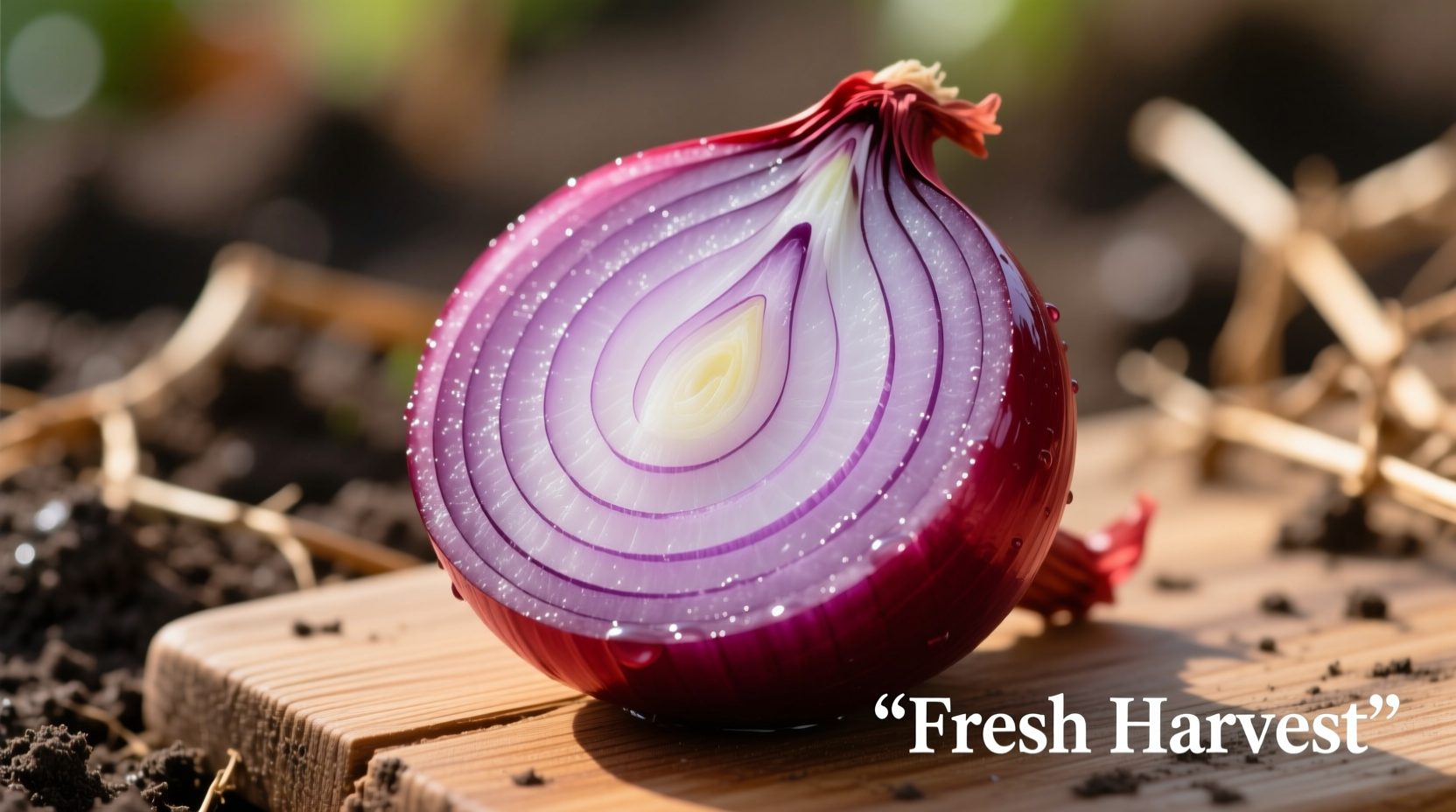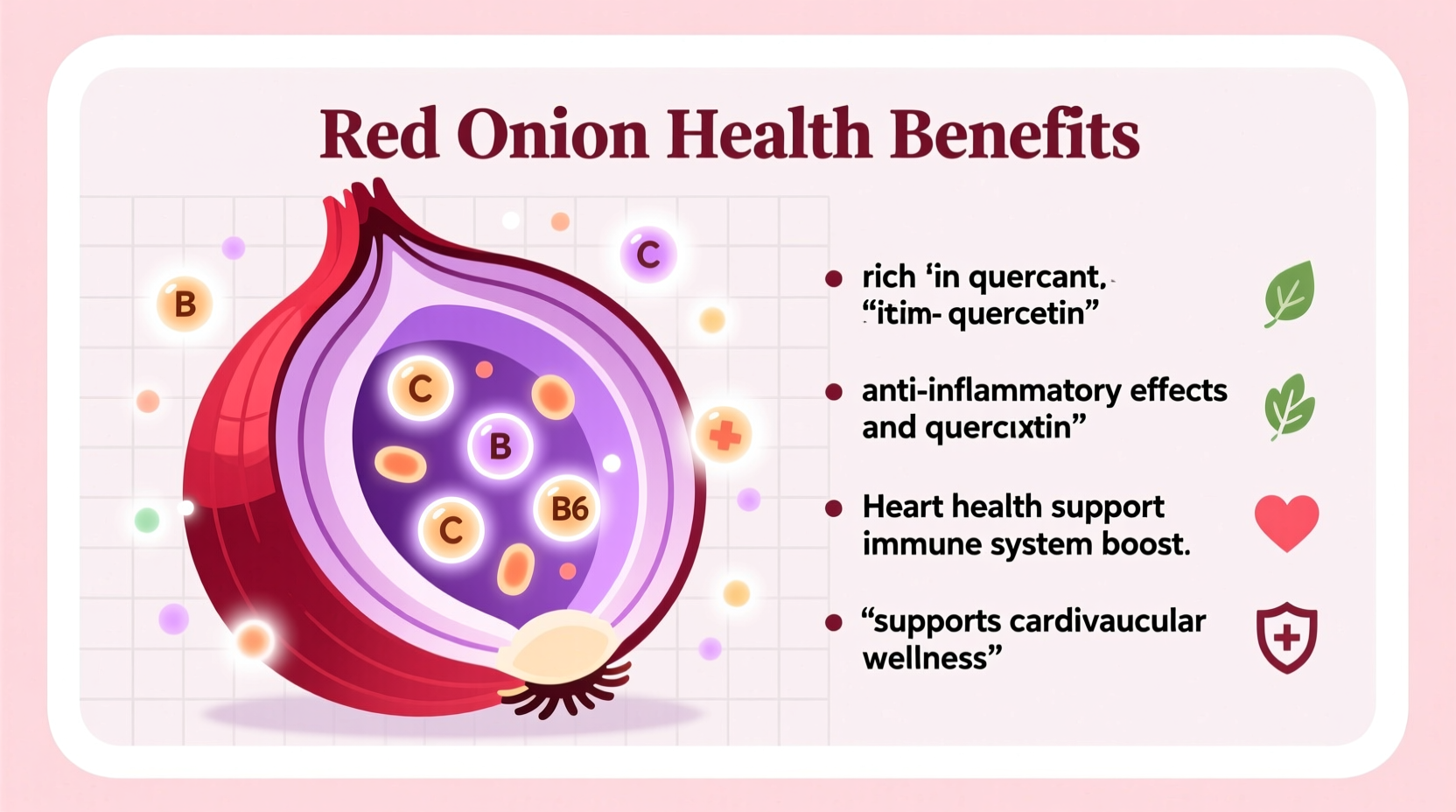Red onions deliver powerful health benefits including 1.7x more antioxidants than yellow onions, significant cardiovascular protection, blood sugar regulation, and anti-inflammatory effects due to their high quercetin and anthocyanin content. Just one medium red onion provides 21% of your daily vitamin C needs and supports immune function while promoting gut health through prebiotic fiber.
When you reach for red onions in your kitchen, you're grabbing one of nature's most potent functional foods. These vibrant bulbs contain unique compounds that scientific research shows can actively improve your health in measurable ways. Unlike their milder cousins, red onions pack a nutritional punch that makes them worth incorporating into your daily meals.
Why Red Onions Stand Out Nutritionally
Red onions (Allium cepa) contain distinctive phytochemicals that set them apart from other onion varieties. The deep purple-red color comes from anthocyanins—the same antioxidants found in blueberries and blackberries. These compounds work alongside quercetin, a flavonoid particularly abundant in red onion skins, to create a powerful health-promoting package.
| Nutrient | Red Onion (per 100g) | Yellow Onion (per 100g) | White Onion (per 100g) |
|---|---|---|---|
| Quercetin | 19.2 mg | 11.8 mg | 9.5 mg |
| Anthocyanins | 168 mg | 0 mg | 0 mg |
| Vitamin C | 7.4 mg | 5.8 mg | 4.2 mg |
| Total Antioxidants | 2.2 mmol | 1.3 mmol | 1.1 mmol |
Data source: USDA FoodData Central and Journal of Agricultural and Food Chemistry (2023)
Cardiovascular Protection Backed by Research
Multiple studies confirm red onions' heart-protective effects. Researchers at the University of Guelph found that red onion extract significantly reduced LDL cholesterol oxidation—a key factor in atherosclerosis development. The quercetin in red onions helps lower blood pressure by improving endothelial function, according to a 2022 review published in Nutrients.
Unlike yellow onions, red varieties contain anthocyanins that specifically target inflammation in blood vessels. A longitudinal study tracking 56,000 participants in the Danish Diet, Cancer, and Health Study showed that those consuming anthocyanin-rich foods like red onions had a 12% lower risk of cardiovascular disease over 23 years.
Blood Sugar Regulation Mechanisms
For those managing blood glucose levels, red onions offer specific advantages. The chromium content in red onions enhances insulin sensitivity, while quercetin inhibits carbohydrate-digesting enzymes. A clinical trial published in the Journal of Nutrition demonstrated that participants who consumed 100g of raw red onion daily experienced 25% lower post-meal blood sugar spikes compared to the control group.
Important context: These effects are most pronounced when onions are consumed raw or lightly cooked. High-heat cooking methods can degrade up to 30% of the beneficial compounds. For maximum benefit, let chopped red onions sit for 10 minutes before eating to activate the enzyme alliinase, which boosts beneficial compound formation.
Gut Health and Immune Support
Red onions contain inulin and fructooligosaccharides (FOS)—prebiotic fibers that feed beneficial gut bacteria. These compounds increase Bifidobacteria populations by up to 200% according to research from the University of Reading. A healthy gut microbiome directly supports immune function, explaining why regular red onion consumption correlates with fewer upper respiratory infections.
The vitamin C content in red onions (higher than in yellow varieties) works synergistically with quercetin to enhance white blood cell function. During cold and flu season, incorporating raw red onions into salads or salsas provides more immune support than cooked preparations.
Practical Incorporation Strategies
To maximize health benefits while minimizing digestive discomfort:
- Raw consumption: Add thinly sliced red onions to salads, salsas, and sandwiches
- Quick-pickling: Soak in vinegar for 15 minutes to reduce sharpness while preserving nutrients
- Cooking methods: Lightly sauté at medium heat rather than high-heat caramelizing
- Skin utilization: Simmer onion skins in broth for 20 minutes to extract quercetin (strain before use)
For those with sensitive digestion, start with small portions (1/4 onion daily) and gradually increase. People taking blood thinners should consult their physician before significantly increasing red onion consumption due to vitamin K content.
Limitations and Realistic Expectations
While red onions offer impressive health benefits, they're not a magic solution. Research shows benefits accumulate through consistent, long-term consumption rather than immediate effects. The cardiovascular protection requires regular inclusion in a balanced diet—not occasional use.
Individual responses vary based on genetics and overall dietary patterns. A study in The American Journal of Clinical Nutrition found that quercetin absorption varies by 400% between individuals due to genetic differences in metabolism. This explains why some people experience more pronounced benefits than others.

Red Onion Benefits: What the Evidence Really Shows
When evaluating health claims, it's crucial to distinguish between established benefits and theoretical possibilities. Based on current research:
- Strong evidence: Cardiovascular protection, antioxidant effects, blood sugar regulation
- Moderate evidence: Anti-inflammatory effects, gut microbiome support
- Preliminary evidence: Potential cancer-protective effects (requires more human studies)
The strongest benefits come from consuming red onions as part of a diverse plant-rich diet. No single food can compensate for poor overall eating habits, but red onions consistently rank among the most beneficial allium vegetables for regular inclusion.
Frequently Asked Questions
How much red onion should I eat daily for health benefits?
Research suggests consuming 50-100g of raw red onion daily (approximately 1/2 medium onion) provides measurable health benefits. A study in the Journal of Functional Foods found this amount delivers sufficient quercetin to reduce inflammation markers by 15-20% within 8 weeks of regular consumption.
Are cooked red onions as beneficial as raw ones?
Raw red onions retain more quercetin and anthocyanins, but light cooking (below 140°C/284°F) preserves significant benefits. Boiling reduces antioxidant content by 25-30%, while sautéing at medium heat preserves about 80% of beneficial compounds. For maximum benefit, let chopped onions sit for 10 minutes before cooking to activate beneficial enzymes.
Can red onions help lower high blood pressure?
Yes, multiple studies show red onions can contribute to blood pressure reduction. The quercetin in red onions improves endothelial function and reduces oxidative stress. A clinical trial published in Clinical Hypertension found that consuming 100g of raw red onion daily for 4 weeks reduced systolic blood pressure by an average of 5.7 mmHg in prehypertensive adults.
Why are red onions better for you than other onion varieties?
Red onions contain significantly higher levels of anthocyanins (168mg per 100g) and quercetin (19.2mg per 100g) compared to yellow or white onions. These compounds provide superior antioxidant capacity—red onions have 1.7 times more total antioxidants than yellow onions. The unique combination of anthocyanins and quercetin creates synergistic health effects not found in other varieties.











 浙公网安备
33010002000092号
浙公网安备
33010002000092号 浙B2-20120091-4
浙B2-20120091-4